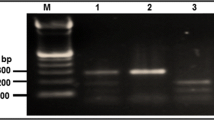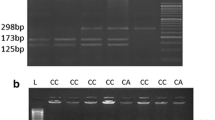Abstract
XPC gene belongs to DNA repair pathway, which is involved in the development of uterine leiomyoma. However, its relationships with leiomyoma risk were never reported. We here hypothesized that XPC gene was associated with the risk of uterine leiomyoma. In this case–control study with a total of 391 leiomyoma cases and 493 tumor-free controls in a reproductive women population in South China, two missense polymorphisms rs2228001 A > C (Lys939Gln) and rs2228000 C > T (Ala499Val) were genotyped by quantitative polymerase chain reaction (qPCR). Then, the associations between these two polymorphisms and leiomyoma risk were investigated. It was revealed that the rs2228000 CT/TT variant genotypes had a decreased leiomyoma risk (adjusted odds ratio = 0.73, 95% confidence interval = 0.54–0.94) compared with rs2228000 CC genotype. Further stratified analysis also revealed that the protective effect of rs2228000 CT/TT on the risk of uterine leiomyoma was more evident among subjects who were younger than 35 years old compared with those with larger tumors (diameter of tumor >5 cm), and those with fewer number of myomas (only one). However, no significant association was observed for leiomyoma risk for rs2228001 A > C. This study indicated that genetic variations in XPC gene are associated with leiomyoma susceptibility in a reproductive women population. It warrants further confirmation in larger prospective studies with different populations.
Similar content being viewed by others
Data Availability
Data will not be shared, because it is part of a clinical database.
References
Stewart EA, Laughlin-Tommaso SK, Catherino WH, Lalitkumar S, Gupta D, Vollenhoven B (2016) Uterine fibroids. Nat Rev Dis Primers 2:16043–16043
Rice KE, Secrist JR, Woodrow EL, Hallock LM, Neal JL (2012) Etiology, diagnosis, and management of uterine leiomyomas. J Midwifery Womens Health 57:241–247
Rein MS (2000) Advances in uterine leiomyoma research: the progesterone hypothesis. Environ Health Perspect 108:791–793
Jeon YT, Kim JW, Park NH, Song YS, Kang SB, Lee HP (2005) DNA repair gene XRCC1 Arg399Gln polymorphism is associated with increased risk of uterine leiomyoma. Hum Reprod 20:1586–1589
Chang WS, Tsai CW, Wang JY, Ying TH, Hsiao TS, Chuang CL, Yueh TC, Liao CH, Hsu CM, Liu SP, Gong CL, Tsai CH, Bau DT (2015) Contribution of X-ray repair complementing defective repair in Chinese hamster cells 3 (XRCC3) genotype to leiomyoma risk. Anticancer Res 35:4691–4696
Hsieh YY, Chang CC, Bau DT, Yeh LS, Tsai FJ, Tsai CH (2008) X-ray repair cross-complementing group 4 (XRCC4) promoter −1394( *)T-related genotype, but not XRCC4 codon 247/intron 3 or xeroderma pigmentosum group D codon 312, 751/promoter −114, polymorphisms are correlated with higher susceptibility to myoma. Fertil Steril 90:1417–1423
Sugasawa K, Ng JM, Masutani C, Iwai S, van der Spek PJ, Eker AP, Hanaoka F, Bootsma D, Hoeijmakers JH (1998) Xeroderma pigmentosum group C protein complex is the initiator of global genome nucleotide excision repair. Mol Cell 2:223–232
D'Errico M, Parlanti E, Teson M, de Jesus BM, Degan P, Calcagnile A, Jaruga P, Bjørås M, Crescenzi M, Pedrini AM, Egly JM, Zambruno G, Stefanini M, Dizdaroglu M, Dogliotti E (2006) New functions of XPC in the protection of human skin cells from oxidative damage. EMBO J 25:4305–4315
Chuang CL, Wang CH, Hsu CH, Hsiao CL, Chen GL, Yen ST, Li HT, Chang WS, Tsai CW, Wang SC, Bau DT (2017) Contribution of double-strand break repair Gene Nijmegen breakage syndrome 1 genotypes, gender difference and smoking status to Taiwanese lung Cancer. Anticancer Res 37:2417–2423
Zhao M, Howard EW, Guo Z, Parris AB, Yang X (2017) p53 pathway determines the cellular response to alcohol-induced DNA damage in MCF-7 breast cancer cells. PLoS One 12:e0175121
He J, Shi TY, Zhu ML, Wang MY, Li QX, Wei QY (2013) Associations of Lys939Gln and Ala499Val polymorphisms of the XPC gene with cancer susceptibility: a meta-analysis. Int J Cancer 133:1765–1775
Hua RX, Zhu J, Jiang DH, Zhang SD, Zhang JB, Xue WQ, Li XZ, Zhang PF, He J, Jia WH (2016) Association of XPC gene polymorphisms with colorectal Cancer risk in a southern Chinese population: a case-control study and meta-analysis. Genes (Basel) 7:73–73
He J, Qiu LX, Wang MY, Hua RX, Zhang RX, Yu HP, Wang YN, Sun MH, Zhou XY, Yang YJ, Wang JC, Jin L, Wei QY, Li J (2012) Polymorphisms in the XPG gene and risk of gastric cancer in Chinese populations. Hum Genet 131:1235–1244
He J, Wang F, Zhu J, Zhang R, Yang T, Zou Y, Xia H (2016) Association of potentially functional variants in the XPG gene with neuroblastoma risk in a Chinese population. J Cell Mol Med 20:1481–1490
Hua RX, Zhuo ZJ, Shen GP, Zhu J, Zhang SD, Xue WQ, Li XZ, Zhang PF, He J, Jia WH (2016) Polymorphisms in the XPC gene and gastric cancer susceptibility in a southern Chinese population. Onco Targets Ther 9:5513–5519
He BS, Xu T, Pan YQ, Wang HJ, Cho WC, Lin K, Sun HL, Gao TY, Wang SK (2016) Nucleotide excision repair pathway gene polymorphisms are linked to breast cancer risk in a Chinese population. Oncotarget 7:84872–84882
Engin AB, Karahalil B, Engin A, Karakaya AE (2011) DNA repair enzyme polymorphisms and oxidative stress in a Turkish population with gastric carcinoma. Mol Biol Rep 38:5379–5386
Wang Y, Li Z, Liu N, Zhang G (2014) Association between CCND1 and XPC polymorphisms and bladder cancer risk: a meta-analysis based on 15 case-control studies. Tumour Biol 35:3155–3165
Zheng Y, Deng Z, Yin J, Wang S, Lu D, Wen X, Li X, Xiao D, Hu C, Chen X, Zhang W, Zhou H, Liu Z (2017) The association of genetic variations in DNA repair pathways with severe toxicities in NSCLC patients undergoing platinum-based chemotherapy. Int J Cancer 141:2336–2347
Dong J, Hu Z, Shu Y, Pan S, Chen W, Wang Y, Hu L, Jiang Y, Dai J, Ma H, Jin G, Shen H (2012) Potentially functional polymorphisms in DNA repair genes and non-small-cell lung cancer survival: a pathway-based analysis. Mol Carcinog 51:546–552
Xue MH, Li GY, Wu XJ, Zhang CX, Zhang CF, Zhu KX (2015) Genetic variability of genes in NER pathway influences the treatment outcome of gastric cancer. Int J Clin Exp Pathol 8:5563–5569
Long XD, Ma Y, Huang YZ, Yi Y, Liang QX, Ma AM, Zeng LP, Fu GH (2010) Genetic polymorphisms in DNA repair genes XPC, XPD, and XRCC4, and susceptibility to helicobacter pylori infection-related gastric antrum adenocarcinoma in Guangxi population, China. Mol Carcinog 49:611–618
Paszkowska-Szczur K, Scott RJ, Serrano-Fernandez P, Mirecka A, Gapska P, Górski B, Cybulski C, Maleszka R, Sulikowski M, Nagay L, Lubinski J, Dębniak T (2013) Xeroderma pigmentosum genes and melanoma risk. Int J Cancer 133:1094–1100
Zhao Z, Zhang A, Zhao Y, Xiang J, Yu D, Liang Z, Xu C, Zhang Q, Li J, Duan P (2018) The association of polymorphisms in nucleotide excision repair genes with ovarian cancer susceptibility. Biosci Rep 38:BSR20180114
Wood RD, Mitchell M, Sgouros J, Lindahl T (2001) Human DNA repair genes. Science 291:1284–1289
Watanabe K, Ikuno Y, Kakeya Y, Ikeno S, Taniura H, Kurono M, Minemori K, Katsuyama Y, Naka-Kaneda H (2019) Age-related dysfunction of the DNA damage response in intestinal stem cells. Inflamm Regen 39:8–8
Anglada T, Repullés J, Espinal A, LaBarge MA, Stampfer MR, Genescà A, Martín M (2019) Delayed γH2AX foci disappearance in mammary epithelial cells from aged women reveals an age-associated DNA repair defect. Aging (Albany NY) 11:1510–1523
Paszkowska-Szczur K, Scott RJ, Górski B, Cybulski C, Kurzawski G, Dymerska D, Gupta S, van de Wetering T, Masojć B, Kashyap A, Gapska P, Gromowski T, Kładny J, Lubiński J, Dębniak T (2015) Polymorphisms in nucleotide excision repair genes and susceptibility to colorectal cancer in the polish population. Mol Biol Rep 42:755–764
Ebili HO, Iyawe VO, Adeleke KR, Salami BA, Banjo AA, Nolan C, Rakha E, Ellis I, Green A, Agboola AOJ (2018) Checkpoint kinase 1 expression predicts poor prognosis in Nigerian breast Cancer patients. Mol Diagn Ther 22:79–90
Kim DH, Lee H, Kim DH, Chae SW, Sohn JH, Kim K, Do SI (2018) High excision repair cross-complementation group 1 expression is associated with favorable prognostic factors in breast cancer. Oncol Lett 1:4995–5003
Suh KJ, Ryu HS, Lee KH, Kim H, Min A, Kim TY, Yang Y, Lee HB, Moon HG, Han SW, Oh DY, Han W, Park IA, Noh DY, Im SA (2019) Prognostic effects of abnormal DNA damage response protein expression in breast cancer. Breast Cancer Res Treat 175:117–127
Bray MJ, Torstenson ES, Jones SH, Edwards TL, Velez Edwards DR (2018) Evaluating risk factors for differences in fibroid size and number using a large electronic health record population. Maturitas 114:9–13
Peddada SD, Laughlin SK, Miner K, Guyon JP, Haneke K, Vahdat HL, Semelka RC, Kowalik A, Armao D, Davis B, Baird DD (2008) Growth of uterine leiomyomata among premenopausal blank and white women. Proc Natl Acad Sci U S A 105:19887–19892
Gupta S, Jose J, Manyonda I (2008) Clinical presentation of fibroids. Best Pract Res Clin Obstet Gynaecol 22:615–626
Zepiridis LI, Grimbizis GF, Tarlatzis BC (2015) Infertility and uterine fibroids. Best Pract Res Clin Obstet Gynaecol 34:66–73
Donnez J, Dolmans MM (2016) Uterine fibroid management: from the present to the future. Hum Reprod Update 22:665–686
Yoo EH, Lee PI, Huh CY, Kim DH, Lee BS, Lee JK, Kim D (2007) Predictors of leiomyoma recurrence after laparoscopic myomectomy. J Minim Invasive Gynecol 14:690–697
Acknowledgements
This study was partially supported by Sanming Project of Medicine in Shenzhen (No.:SZSM201406007). We thank Drs. Sun, Chen, Guan, Chi, Jian, Zhu, and Liu for sample collecting and histological examinations.
Funding
This work was partially supported by Sanming Project of Medicine in Shenzhen (No.:SZSM201406007).
Author information
Authors and Affiliations
Contributions
Conceived and designed the experiments: BL. Performed the experiments: ZL and ML. Collected samples: ML. Analyzed data: ZL and BL. Contributed to the writing of manuscript: ZL and BL. All authors approved the final manuscript.
Corresponding author
Ethics declarations
All procedures performed in studies involving human participants were in accordance with the ethical standards of the institutional and/or national research committee and with the 1964 Helsinki declaration and its later amendments or comparable ethical standards.
Ethics Approval
All the study participants gave a written informed consent. A formal consent was also issued by the Ethics Committee of the Baoan Maternal and Child Health Hospital, Jinan University (No. of Institutional Review Board: LLSC2018-02-01).
Consent for Publication
Not applicable, the manuscript doesn’t contain any individual person’s data.
Conflict of Interest
Authors declare no conflict of interest.
Additional information
Publisher’s Note
Springer Nature remains neutral with regard to jurisdictional claims in published maps and institutional affiliations.
Rights and permissions
About this article
Cite this article
Liu, ZQ., Lu, MY. & Liu, B. Polymorphisms in XPC Gene and Risk of Uterine Leiomyoma in Reproductive Women. Pathol. Oncol. Res. 26, 1459–1464 (2020). https://doi.org/10.1007/s12253-019-00720-2
Received:
Accepted:
Published:
Issue Date:
DOI: https://doi.org/10.1007/s12253-019-00720-2




